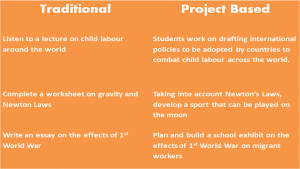The Buck Institute for Education describes Project Based Learning as a teaching method in which students gain knowledge and skills by working for an extended period of time to investigate and respond to an engaging and complex question, problem, or challenge
In other words, Project-based learning is a student-centered method of teaching and learning in which the student learns about a subject through problem-solving. This means that students engage complex, challenging problems and collaboratively work toward their resolution. Project Based Learning is about students connecting knowledge to real-world problems; in addition, the motivation to solve a problem becomes the motivation to learn.
How does Project Based Learning compare to Traditional Methods of Learning?
In traditional methods, students would listen to a lecture, complete a worksheet or write an essay. These were usually done on an individual basis. What is unique about Project Based Learning is that it integrates 21st-century learning skills into projects. For example, many of the activities include working collaboratively in teams and brainstorming possible solutions to problems. In addition, creativity plays a role as students as encouraged to come up with solutions to impending problems with personal interest and a desire for exploration.
Another characteristic is the multifaceted assessment that project based learning promotes. Students are graded on creativity, critical thinking, innovation, presentation, collaboration as well as traditional attributes such as wording, content accuracy, and organization and presentation mechanics. Below is a chart depicting differences




